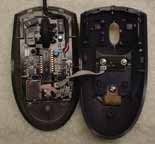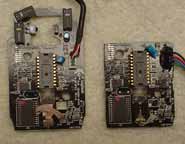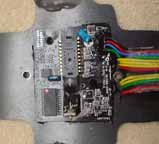After the optical mouse in Excuse was found to be speed limited, a search for a faster mouse was undertaken. Apparently, the timing was right because Microsoft just introduces the IntelliMouse and Logitech came out with the MX series of mice. Both advertised speed rand of up to 40 inches per second. PS2 compatible examples of both were purchased. Both the IntelliMouse and the MX300 were tried with the PAK VIA. Both worked with the following changes: First, a 10K pull up resistor was added to the mouse clock pin. I assume that the pull up resistor is required to indicate to the mouse that PS2 mode is required. Second, a warm reset of the PAK VIA and mouse are required after power-on. After the warm reset, a delay is required before either mouse can be used. The IntelliMouse requires 1.6 seconds delay and the MX300 requires 1.1 seconds delay.
 Upon disassembly, the Microsoft mouse appeared to be way too complicated to hack, so it went into daily duty replacing the ball mouse on my main computer. The Logitech MX300 was much simpler with a familiar Agilent Optical Mouse chip and a Cypress micro controller. The Agilent chip was marked "A2020" so I assumed that it was a ADNS2020. No chip is listed on their web site with that number and a request for a data sheet was ignored. Upon disassembly, the Microsoft mouse appeared to be way too complicated to hack, so it went into daily duty replacing the ball mouse on my main computer. The Logitech MX300 was much simpler with a familiar Agilent Optical Mouse chip and a Cypress micro controller. The Agilent chip was marked "A2020" so I assumed that it was a ADNS2020. No chip is listed on their web site with that number and a request for a data sheet was ignored.
 Much of the MX300 PCB was dedicated to wheels and buttons that were not needed. Those parts of the board were cut off with a Moto-tool. The resulting, smaller board can be seen in the photos. The board could be cut more, but it is good enough for now. Note: The newer MX310 appears to have a simpler board so may be cut down more. Much of the MX300 PCB was dedicated to wheels and buttons that were not needed. Those parts of the board were cut off with a Moto-tool. The resulting, smaller board can be seen in the photos. The board could be cut more, but it is good enough for now. Note: The newer MX310 appears to have a simpler board so may be cut down more.
 The electronics were installed in a test Sumo and everything worked! The electronics were installed in a test Sumo and everything worked!
Since the desired measure is forward speed, the technique used is to a) clear the mouse buffer, b) wait a few milliseconds, c) read the mouse buffer. Theoretically, the milliseconds wait time could be used to scale the output to a useable level.
Interesting observation: The PAK VIA sends a maximum of "01111111". That is the output at about 28 to 30 inches per second. Increasing the speed up to 36 inches per second does not change the output of "01111111". There was no overflow indication at this higher speed.
Several alternative programs were developed to test the functions. The mouse would sense whenever the Sumo was slowed or stopped by an obstacle and would initiate evasive action (spinning). Even climbing a ramp was detected and evasive action was initiated remarkably quickly. But the mouse occasionally picked up a dead spot on the Sumo ring and spun. The mouse was mounted too high off of the surface for 100% reliable operation. Lowering the mouse was not practical, so the experimental chassis was disassembled and redesigned to place the mouse very close to the surface. The new chassis is under construction now and experiments will soon continue. |